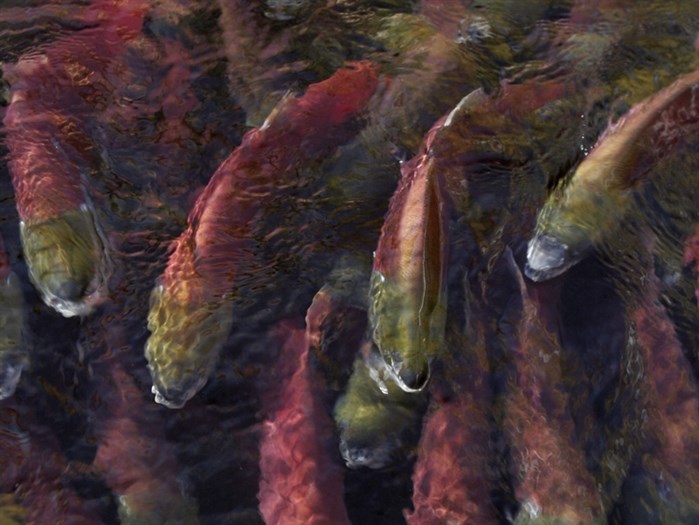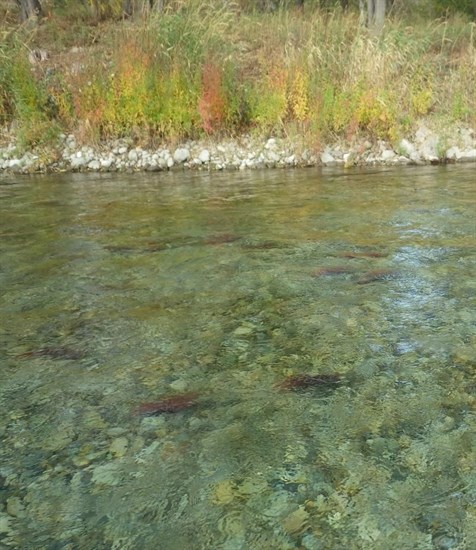
Sockeye Salmon spawning in the Okanagan River Channel.
Image Credit: Submitted/Okanagan Nation Alliance Fisheries Department
December 28, 2023 - 7:00 AM
The Adams River is famous for huge runs of sockeye salmon each fall as the river runs red with spawning and dying fish.
That’s not something that Okanagan residents expect from the Okanagan River and its tributaries but thousands of sockeye made it into Okanagan Lake and its spawning channels last year with many more spawning downstream.
“Adams River is the biggest sockeye run on the Fraser River system so, yes, that’s a lofty goal (to have similar numbers) but we should definitely see larger returns in future years,” Elinor McGrath, fisheries biologist with Okanagan Nation Alliance, told iNFOnews.ca.
“The Okanagan Nation Alliance has been out planting hatchery fry into Okanagan Lake. What that results in, usually, is the fry home back to the area that they were released in. If you release them into Mission Creek, most of the adults come back into Mission Creek.”
Last year was a particularly good year for the sockeye, which had all but disappeared from the Okanagan River system until the Okanagan Nation Alliance opened its own hatchery in Penticton in 2014.
READ MORE: Why Okanagan salmon hatcheries are more successful than their controversial counterparts
There were 113,393 sockeye spawners counted in the river system in 2022, including 74,168 near Oliver, 34,525 in the Penticton Channel of Okanagan River and Shingle Creek and about 4,700 in Okanagan Lake tributaries, mainly Trout, Powers, Equesis and Mission creeks.
It's impossible to say if those numbers, at least downstream of Okanagan Lake, are returning to historic levels.
“We’ve got a lot more qualitative information from the traditional knowledge holders about how the river was thick with fish, it was all red, you could essentially walk across their backs kind of thing but it’s hard to estimate a number from that,” McGrath said. “We had coho, steelhead. We had lots of different species that were really abundant and easy to catch.”
While the fish ladder at the Penticton dam had been opened briefly for experimental purposes in the past, last year was the first time it was given a significant opening because of the abundance of salmon in the system.
It was a dramatically different picture this year when only about 50 Sockeye made it into Okanagan Lake and the preliminary count for the entire system shows less than 20,000 sockeye in the system in 2023.
That’s due, in part, to the fact that Sockeye generally have a four-year cycle where they reach adulthood then return to their original home to spawn and die and 2023 was a slow year.
But heat and drought played a significant role as well.
“Most of the Chinook and Sockeye held in the Columbia River in Wells Pool down by Brewster until fairly late in the summer because the temperatures were really high and that’s the main thing that blocks them from moving up,” McGrath said.

Image Credit: Submitted/Okanagan Nation Alliance Fisheries Department
The salmon can return to spawning areas in June and July but once the temperature in rivers and lakes hits 22 Celsius, they are blocked.
When they were finally able to get upriver by the third week of August, they had already suffered some fatalities while waiting to head upstream. They spawn in mid-October.
Once in the Okanagan, low or no flows in creeks like Vaseux and Shuttleworth prevented some from spawning.
“This year, if we had had a lot of salmon returning, it would have been really difficult for them, in some of the creeks, to just get in," McGrath said.
The sockeye are about twice the size of kokanee and come in at 40-55 cm so obviously, they need more water to travel up creeks to spawn.
There are some chinook coming into the system as well but in very small numbers, less than 100 spawners.
“This population is endangered and is currently being considered for listing under the Species at Risk Act,” McGrath said.
The Okanagan Nation Alliance is now trying to get those numbers up.
The demise of the salmon stocks was due to a number of dams along the Columbia and Okanagan rivers but, more importantly, the water was taken from rivers and lakes to irrigate European-planted crops while rivers and streams were straightened and channelized.
In the 1970s, Albert Saddleman, who went on to become chief of the Okanagan Indian Band, started working to bring the sockeye back into the system, according to a report by the Okanagan Nation Alliance called: 'i? sm? ay?áy?t?t t? sc?win (Our Salmon Story): Honouring Syilx Responsibilities and Relationships to Salmon.'
It was a slow process and it took until 2004 for the Syilx Nation to release its first Sockeye fry into Skaha Lake, taking them from a federal fisheries facility near Lumby. By 2024 the Okanagan Nation Alliance opened its own hatchery in Penticton.
Not only were fry introduced to streams in the hopes they would return to spawn four years later, Okanagan Nation Alliance and others worked to naturalize some streams, including parts of Mission Creek and Penticton Creek. Work will begin on Vernon Creek next summer.
READ MORE: Smashing down concrete walls might make Vernon’s Polson park more useable
In Mission Creek – the single largest source of water flowing into Okanagan Lake – some of the channel is restoring itself.
“There has been quite a bit of sediment transport over the last years because of the high freshets that we’ve been having,” McGrath said. “It has caused some problems with aggradation but it’s also deposited a lot of really nice gravel and kind of created that meandering heterogeneity in the streambed that’s actually good for fish.”
The Mission Creek Restoration Initiative is working with Okanagan Nation Alliance to increase the areas to be naturalized.
The relatively huge run last year is cause of optimism that may be fulfilled when those fry return to spawn.
“We should have a great run in 2026 – fingers crossed,” McGrath said.
And fingers crossed is key. Not only do the Sockeye have to survive the rigours of ocean life but they also need to be able to reach spawning streams that aren’t blocked by overly warm lakes and limited by inadequate water supplies.
To contact a reporter for this story, email Rob Munro or call 250-808-0143 or email the editor. You can also submit photos, videos or news tips to the newsroom and be entered to win a monthly prize draw.
We welcome your comments and opinions on our stories but play nice. We won't censor or delete comments unless they contain off-topic statements or links, unnecessary vulgarity, false facts, spam or obviously fake profiles. If you have any concerns about what you see in comments, email the editor in the link above. SUBSCRIBE to our awesome newsletter here.
News from © iNFOnews, 2023